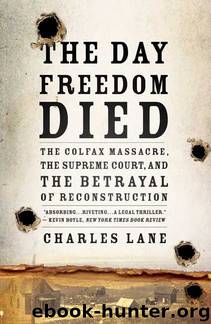The Day Freedom Died: The Colfax Massacre, the Supreme Court, and the Betrayal of Reconstruction by Charles Lane

Author:Charles Lane
Language: eng
Format: mobi, epub
Tags: Civil Rights, United States, African American, Law, Civil War Period (1850-1877), History
ISBN: 0805089225
Publisher: Henry Holt and Co.
Published: 2008-03-03T23:00:00+00:00
ON THE AFTERNOON OF MARCH 4, THE DEFENSE ROSE. WILLIAM R. WHITAKER made no effort to deny that prisoners had been killed. But he did intend to explain and to justify it. Beckwith had tried to convince the jury that the Negroes in Colfax had been attacked by a lawless white mob. In truth, Whitaker argued, the only mob in Colfax had been a black one. Negro provocations and Negro threats had forced the whites to fight. It was because of the Negroes’ treacherous firing on the flag of truce, which felled Hadnot and Harris, that the blood of the white men had boiled over, with such unfortunate consequences. But, in any case, Whitaker said, only two of the white men in court, Bill Irwin and Johnnie Hadnot, had even taken part in this defensive battle, and the evidence would show that both of them had left Colfax before the slaughter of the prisoners began, Irwin returning home and Hadnot accompanying his wounded uncle on a steamboat to Alexandria.
The first defense witness was Wilson L. Richardson, who described fleeing across the river on April 2, in fear of his life because of the Negro riot. Charles Smith, the white Republican who facilitated the abortive peace talks between whites from Montgomery and Ward’s men, asserted that he had narrowly escaped from a gang of armed blacks yelling, “Kill the damned white son of a bitch.” Smith claimed that Alexander Tillman, far from being an innocent victim, was the architect of the Negroes’ military-style trench. O. J. Butler and Sam Cuney the colored men who had opposed the Negro posse from the beginning, said that they too, had been run out of town because they refused to go along with William Ward’s violent designs.
The defense called its army of alibi witnesses, some of whom were men and women of color. Two of Alfred Lewis’s Negro servants swore that he was home all day on Easter Sunday, as did colored employees of Tom Hickman. Bill Irwin’s Negro servants swore that he had returned home by Sunday night. But for the most part, the witnesses were white friends and relatives of the accused. Several such men and women put Prudhomme Lemoine in church on Easter Sunday and said that Donas Lemoine and Austin Gibbons were at a farm miles away from Colfax, where they supposedly killed a hog. Maurice and Benjamin Kraft testified that on the day of the fight, Clement Penn was sitting on a tree limb outside their store on the Rapides Parish side of the river. Penn watched the battle from there, they said, though he visited the town briefly on the night of the thirteenth to help take out a wounded white man.
The dramatic climax of the defense testimony came when Whitaker called on J. C. Morantini to describe how the Negroes had violated the sacred flag of truce. Morantini lived on the Rapides Parish side of the Red River, on a spit of land just opposite Colfax. He had aided William R.
Download
The Day Freedom Died: The Colfax Massacre, the Supreme Court, and the Betrayal of Reconstruction by Charles Lane.epub
This site does not store any files on its server. We only index and link to content provided by other sites. Please contact the content providers to delete copyright contents if any and email us, we'll remove relevant links or contents immediately.
| Africa | Americas |
| Arctic & Antarctica | Asia |
| Australia & Oceania | Europe |
| Middle East | Russia |
| United States | World |
| Ancient Civilizations | Military |
| Historical Study & Educational Resources |
Cat's cradle by Kurt Vonnegut(14768)
Pimp by Iceberg Slim(13787)
Underground: A Human History of the Worlds Beneath Our Feet by Will Hunt(11841)
4 3 2 1: A Novel by Paul Auster(11800)
The Radium Girls by Kate Moore(11626)
Wiseguy by Nicholas Pileggi(5323)
American History Stories, Volume III (Yesterday's Classics) by Pratt Mara L(5139)
Perfect Rhythm by Jae(5075)
The Fire Next Time by James Baldwin(5024)
Paper Towns by Green John(4805)
Pale Blue Dot by Carl Sagan(4626)
A Higher Loyalty: Truth, Lies, and Leadership by James Comey(4555)
The Mayflower and the Pilgrims' New World by Nathaniel Philbrick(4285)
The Doomsday Machine by Daniel Ellsberg(4250)
Killers of the Flower Moon: The Osage Murders and the Birth of the FBI by David Grann(4192)
Too Much and Not the Mood by Durga Chew-Bose(4097)
The Sympathizer by Viet Thanh Nguyen(4096)
The Borden Murders by Sarah Miller(4025)
Sticky Fingers by Joe Hagan(3916)
